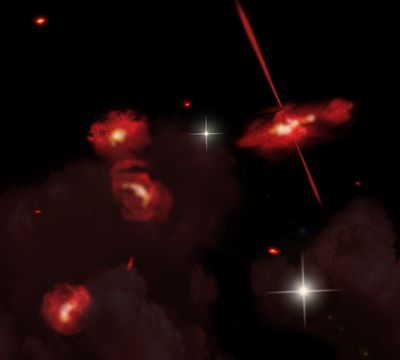
In the distant reaches of the universe, almost 13 billion light-years from Earth, a strange species of galaxy lay hidden. Cloaked in dust and dimmed by the intervening distance, even the Hubble Space Telescope couldn’t spy it. It took the revealing power of NASA’s Spitzer Space Telescope to uncover not one, but four remarkably red galaxies. And while astronomers can describe the members of this new “species,” they can’t explain what makes them so ruddy.
“We’ve had to go to extremes to get the models to match our observations,” said Jiasheng Huang of the Harvard-Smithsonian Center for Astrophysics (CfA). Huang is lead author on the paper announcing the find, which was published online by the Astrophysical Journal.
Spitzer succeeded where Hubble failed because Spitzer is sensitive to infrared light – light so red that it lies beyond the visible part of the spectrum. The newfound galaxies are more than 60 times brighter in the infrared than they are at the reddest colors Hubble can detect.
Galaxies can be very red for several reasons. They might be very dusty. They might contain many old, red stars. Or they might be very distant, in which case the expansion of the universe stretches their light to longer wavelengths and hence redder colors (a process known as redshifting). All three reasons seem to apply to the newfound galaxies.
All four galaxies are grouped near each other and appear to be physically associated, rather than being a chance line-up. Due to their great distance, we see them as they were only a billion years after the Big Bang – an era when the first galaxies formed.
“Hubble has shown us some of the first protogalaxies that formed, but nothing that looks like this. In a sense, these galaxies might be a ‘missing link’ in galactic evolution” said co-author XianZhong Zheng of Purple Mountain Observatory.
Next, researchers hope to measure an accurate redshift for the galaxies, which will require more powerful instruments like the Large Millimeter Telescope or Atacama Large Millimeter Array. They also plan to search for more examples of this new “species” of extremely red galaxies.
“There’s evidence for others in other regions of the sky. We’ll analyze more Spitzer and Hubble observations to track them down,” said XianZhong Zheng.




